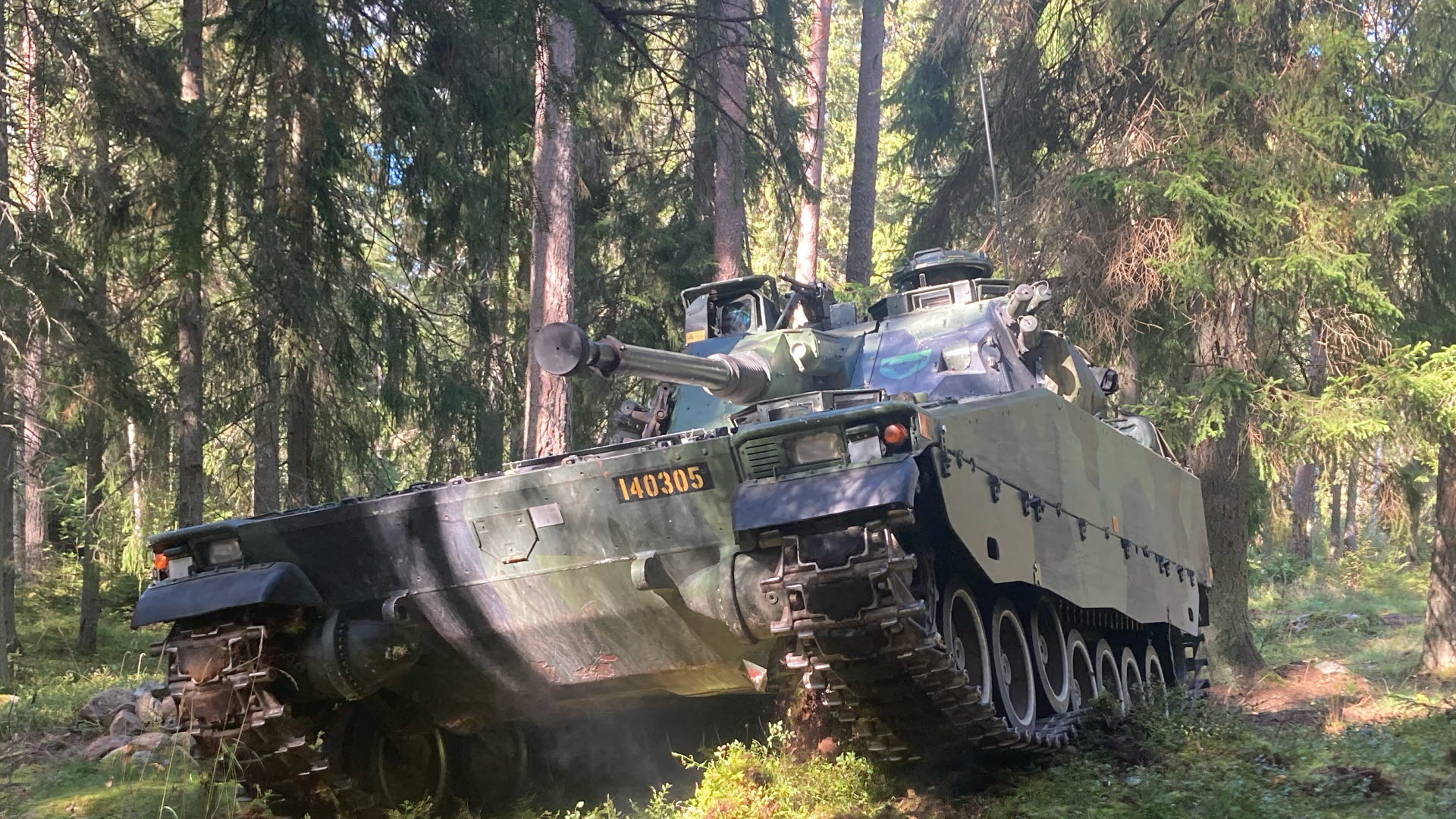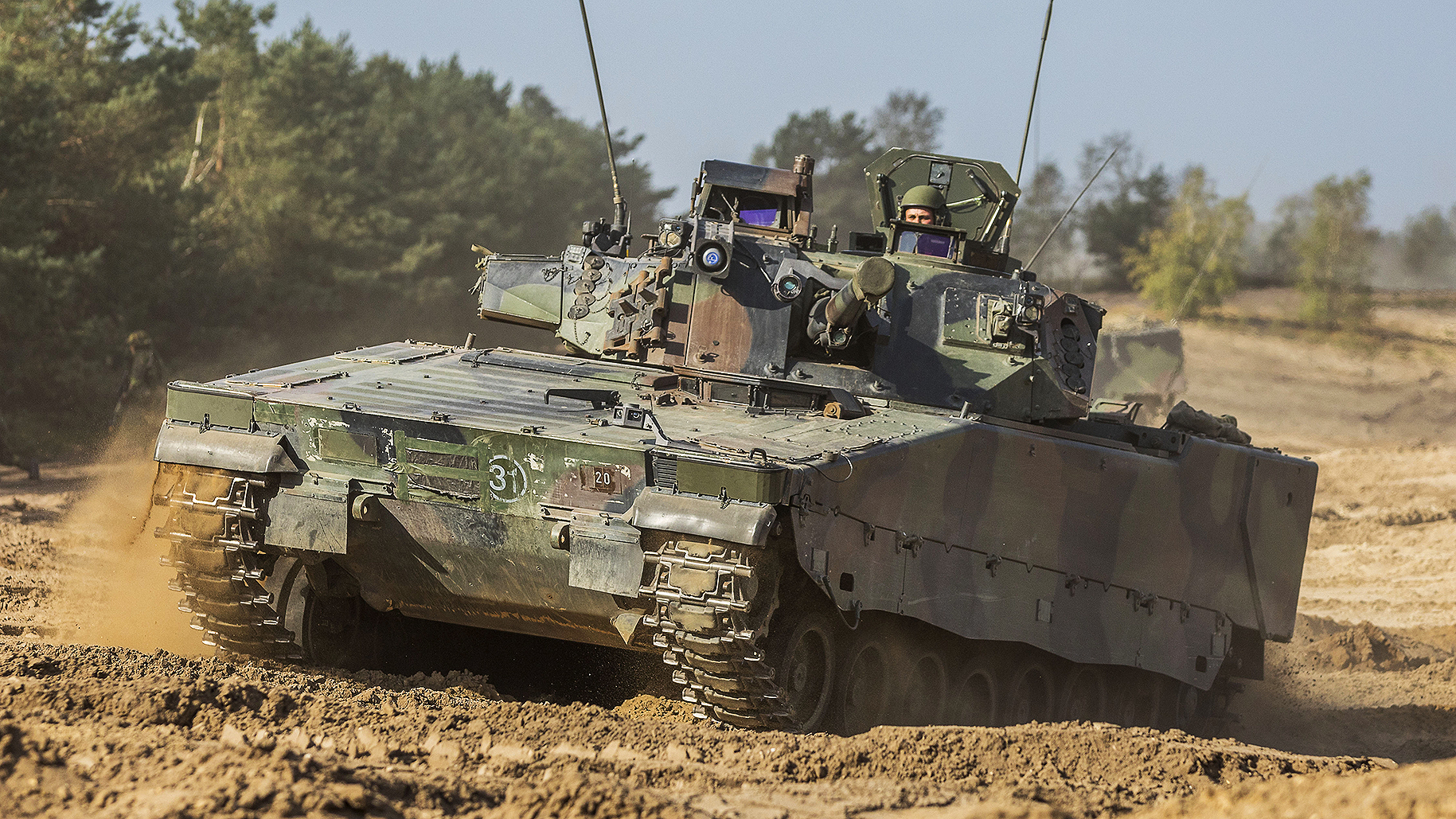Advanced CV90 series infantry fighting vehicles, or IFVs, are the standout item in Sweden’s new package of military aid to Ukraine, announced by the government in Stockholm today. While a Swedish arms transfer had been expected, previously only the Archer self-propelled artillery system had actually been confirmed, with the CV90 now ensuring that Ukraine will also get its hands on one of the most capable IFVs currently available in Europe.
The package unveiled today is valued at around $419 million and as well as IFVs and self-propelled artillery, it also includes NLAW anti-tank weapons, mine-clearing equipment, and assault rifles. The number of Archers to be supplied has not been revealed, but Sweden has 48 of these systems, which combine a 155mm gun-howitzer with a 6×6 wheeled chassis, at its disposal.
“Ukraine’s victory in this war is of almost indescribable importance,” Swedish Prime Minister Ulf Kristersson told a news conference today, as he described Ukraine’s resistance to the Russian full-scale invasion as fighting for the freedom of all of Europe.
“That’s one of the biggest reasons why so many countries are doing so much to help Ukraine right now,” Kristersson said. “The moral support is important, but also our joint security.”
While the exact number of CV90 series IFVs to be supplied to Kyiv hasn’t been announced, Sweden has said it will deliver “about 50.”

According to data from the International Institute for Strategic Studies (IISS), in 2022 the Swedish Armed Forces had 369 examples of the CV9040 (known locally as the Strf 9040) version, of which 54 were outfitted as Stripbv 90 command post vehicles. In addition, Sweden has another 42 examples of the Epbv 90 version, a specialist reconnaissance vehicle used for directing artillery and mortar fire. Neither the Stripbv 90 nor Epbv 90 are fitted with a main gun. In addition, other CV90-based vehicles are in Swedish service as self-propelled mortar systems, self-propelled anti-aircraft guns, and armored recovery vehicles.

Sweden’s CV90, or Combat Vehicle 90 series, was originally schemed in the mid-1980s as a family of fighting vehicles and has resulted in a wide variety of variants for different missions and customer requirements. The vehicle began life as a joint effort involving the Swedish Defense Materiel Administration as well as two local companies, Hägglunds and Bofors.
Today, the CV90 is a product of BAE Systems Hägglunds and more than 1,280 vehicles have been completed in over a dozen main variants. CV90s are in service or have been ordered by eight countries, five of them currently members of NATO: Denmark, Estonia, Finland, the Netherlands, Norway, Sweden, Switzerland, and Slovakia.
In IFV form, the CV90 carries notably hard-hitting main armament, with options of 30mm, 35mm, and 40mm cannons in a turret that has a full 360-degree traverse. With a 40mm Bofors autocannon in a stabilized turret, the CV9040 used by the Swedish Armed Forces carries the most potent armament of any Western European IFV. There is also a coaxial 7.62mm machine gun.

While the particular variant of the CV9040 being supplied to Ukraine has not been confirmed, it’s possible that Sweden will deliver the CV9040C version that was specifically modified for international operations and has since also been used for crew training. This model has an enhanced level of armor protection, “considerably higher” than in the basic version, according to the Swedish Armed Forces. Specific protection measures are designed to offer better defense against mines, small-caliber ammunition, and grenades. There are also laser protection devices on the crew’s periscopes to shield their eyes from harmful laser light.

Weighing just over 25 tons when prepared for combat, the CV9040 has a capacity for a maximum of eight troops and is operated by a crew of three: commander, driver, and gunner. In Swedish service, however, the basic CV9040’s troop complement is normally reduced to a squad of seven, together with their full equipment, while the up-armored CV9040C version has a capacity for six soldiers, as a result of the additional weight of its modifications.
The Nordic origins of the CV9040 ensure that it has a very good level of mobility over snow and through marsh and swamps, which could be of significant benefit to Ukraine. It’s also designed to operate in extremely cold conditions.

Overall, as a modern and highly effective IFV, the CV9040 will bring to Ukraine many of the same capabilities offered by the U.S.-supplied M2 Bradley, which we have discussed at length in the past. The American IFV will, initially at least, also be supplied in broadly similar numbers, with 50 Bradleys now heading to the embattled country.
And, while the CV9040 lacks anti-tank missiles, like the TOW missiles on the M2 Bradley, its Bofors gun is already a powerful weapon against opposition Russian tanks, especially those of the earlier generation, not to mention Soviet-era IFVs. At the same time, a choice of 40mm ammunition means the same gun can also take on a wide range of other targets, too, including more lightly protected objectives including enemy personnel.

Together with the Bradley, the CV9040 goes some of the ways toward meeting Kyiv’s longstanding request for modern Western armor. Although both fall short of the all-round package of armor, firepower, and mobility offered by a modern Western main battle tank, these two IFVs are among the most capable of their kind and are far more realistic prospects on the modern battlefield than the Cold War-era BMP series that still makes up the majority of Ukraine’s IFV fleet.

Like the Bradley, the CV9040 will be able to move Ukrainian troops around more safely in high-risk areas while at the same time providing a significant degree of anti-tank and anti-troop capabilities.
Should the Ukrainian Armed Forces proceed with a promised future offensive to liberate Crimea, for example, modern IFVs like the CV9040 will likely play a prominent role, bringing a new level of troop survivability and maneuverability.
Prior to the pledges to supply the Bradley and the CV9040, the most modern IFV that was approved for transfer to Kyiv was the German Marder. This, while a more modern proposition than the BMP-1/2 series, is a generation older than the U.S. and Swedish IFVs. Otherwise, the only other vehicles in this class that have been made available to Ukraine are other BMPs, taken from the stocks of other European NATO countries.
What’s more, while the initial batch of 50 or so CV9040s earmarked for Ukraine represents a fairly small force, it’s possible that other CV90 operators might also provide some of their vehicles. A coalition of countries could potentially team together in such a project, similar to the proposal for the multinational transfer of Leopard 2 tanks recently put forward by Poland.
For Sweden, too, the transfer of high-end military equipment like this is significant. Previously, other than a consignment of Hellfire missiles in their coastal defense form, Sweden has not provided heavier weaponry to Kyiv.
Therefore, the latest package marks a major policy change, the significance of which is only increased by Sweden currently holding the rotating European Union presidency as well as having applied (alongside Finland) to join NATO.
Today’s announcement will likely only be the start of what could be a very busy few days in terms of providing military aid to Ukraine. Tomorrow, defense ministers from around 50 countries will meet at Ramstein Air Base in Germany to discuss the next steps in arming Ukraine. Ultimately, this could well see a conclusion to the long-running debate over whether Germany will approve the transfer of Leopard 2 tanks, including those taken from the stocks of third-party countries.
In the meantime, with the transfer of the M2 Bradley and now the CV9040 confirmed, Ukraine will, at the very least, have in the future two of the most capable Western infantry fighting vehicles at its disposal.
Update, 11:00 A.M PST: The original version of this story stated that Sweden currently has 35 Archer self-propelled artillery systems, a figure provided in The Military Balance 2022 from the International Institute for Strategic Studies. In a press conference today, the Swedish Minister of Defense, Pål Jonson, confirmed that Sweden actually has 48 Archers. These comprise 24 in active use and 24 in storage (originally built for Norway but then not delivered). Of these, 20 are immediately available for delivery.
With thanks to @SebCraenen.
Contact the author: thomas@thedrive.com
